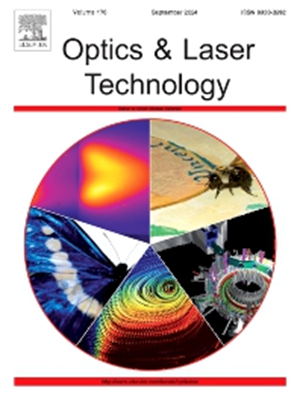Model-based tip-tilt correction for segmented mirror of space telescope using extended beacon
IF 4.6
2区 物理与天体物理
Q1 OPTICS
引用次数: 0
Abstract
A model-based tip-tilt correction method using extended beacons is proposed for aligning the segmented mirror of space telescopes. This method is based on the relationship between the low spatial frequency content of images and the coefficients of Chebyshev segmented tip-tilt (CSTT) modes. Tip-tilt correction is accomplished by introducing positive CSTT modal biases with known amplitudes and capturing 2N-1 focal images in each correction cycle, where N is the number of segments. The performance of the method is evaluated through both simulations and experiments. The results demonstrate that the tip-tilt errors can be effectively corrected within only a small number of iterations, achieving an accuracy of λ/30. Additionally, the impacts of various factors on the correction performance are analyzed, including spectral bandwidth, image noise, the presence of piston errors and figure errors, and the number of mirror segments. The proposed method does not require additional optical components and offers high accuracy along with low computational complexity, making it highly suitable for cophasing of earth-observation segmented space telescopes.
求助全文
约1分钟内获得全文
求助全文
来源期刊
CiteScore
8.50
自引率
10.00%
发文量
1060
审稿时长
3.4 months
期刊介绍:
Optics & Laser Technology aims to provide a vehicle for the publication of a broad range of high quality research and review papers in those fields of scientific and engineering research appertaining to the development and application of the technology of optics and lasers. Papers describing original work in these areas are submitted to rigorous refereeing prior to acceptance for publication.
The scope of Optics & Laser Technology encompasses, but is not restricted to, the following areas:
•development in all types of lasers
•developments in optoelectronic devices and photonics
•developments in new photonics and optical concepts
•developments in conventional optics, optical instruments and components
•techniques of optical metrology, including interferometry and optical fibre sensors
•LIDAR and other non-contact optical measurement techniques, including optical methods in heat and fluid flow
•applications of lasers to materials processing, optical NDT display (including holography) and optical communication
•research and development in the field of laser safety including studies of hazards resulting from the applications of lasers (laser safety, hazards of laser fume)
•developments in optical computing and optical information processing
•developments in new optical materials
•developments in new optical characterization methods and techniques
•developments in quantum optics
•developments in light assisted micro and nanofabrication methods and techniques
•developments in nanophotonics and biophotonics
•developments in imaging processing and systems

 求助内容:
求助内容: 应助结果提醒方式:
应助结果提醒方式:


